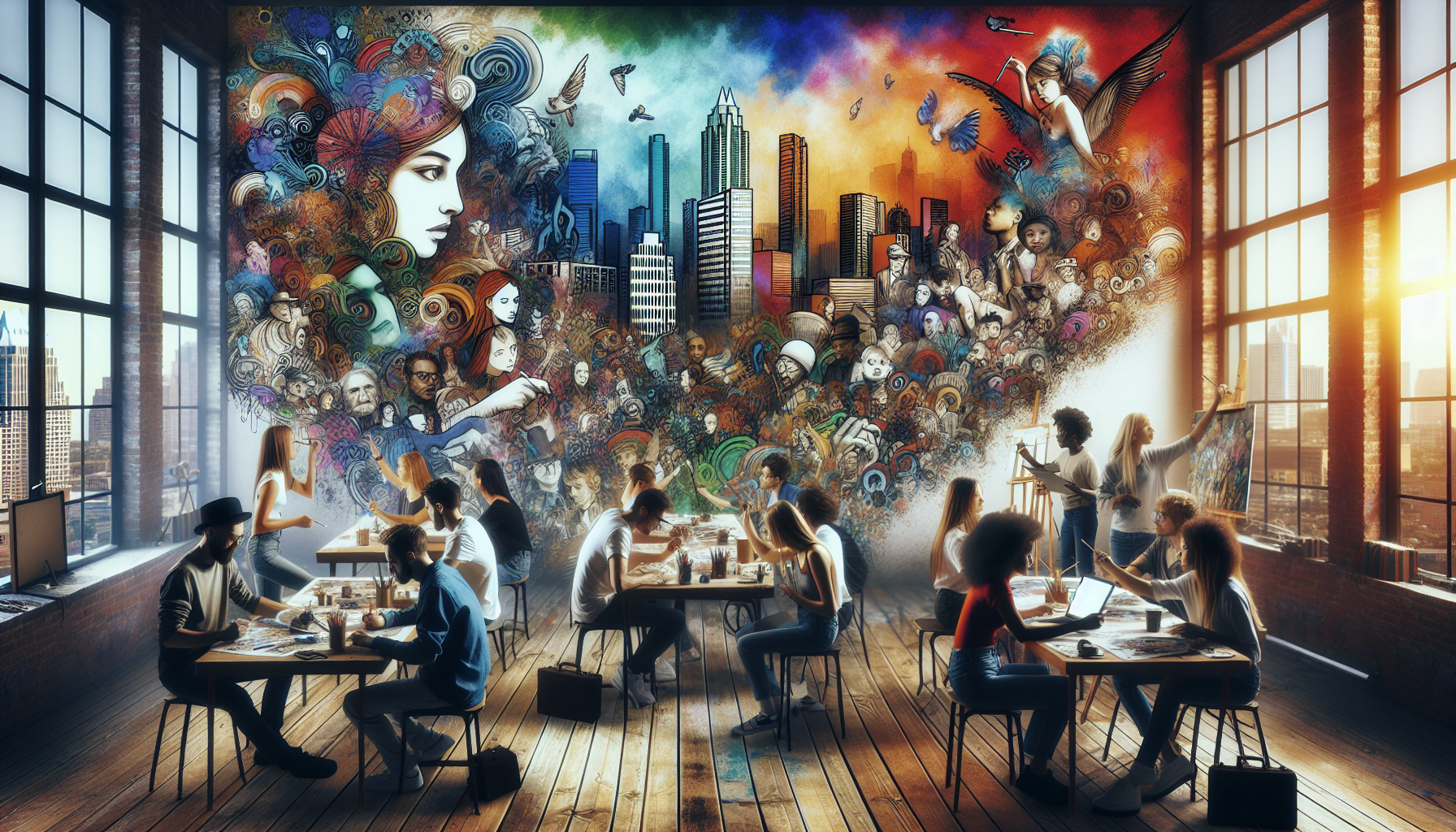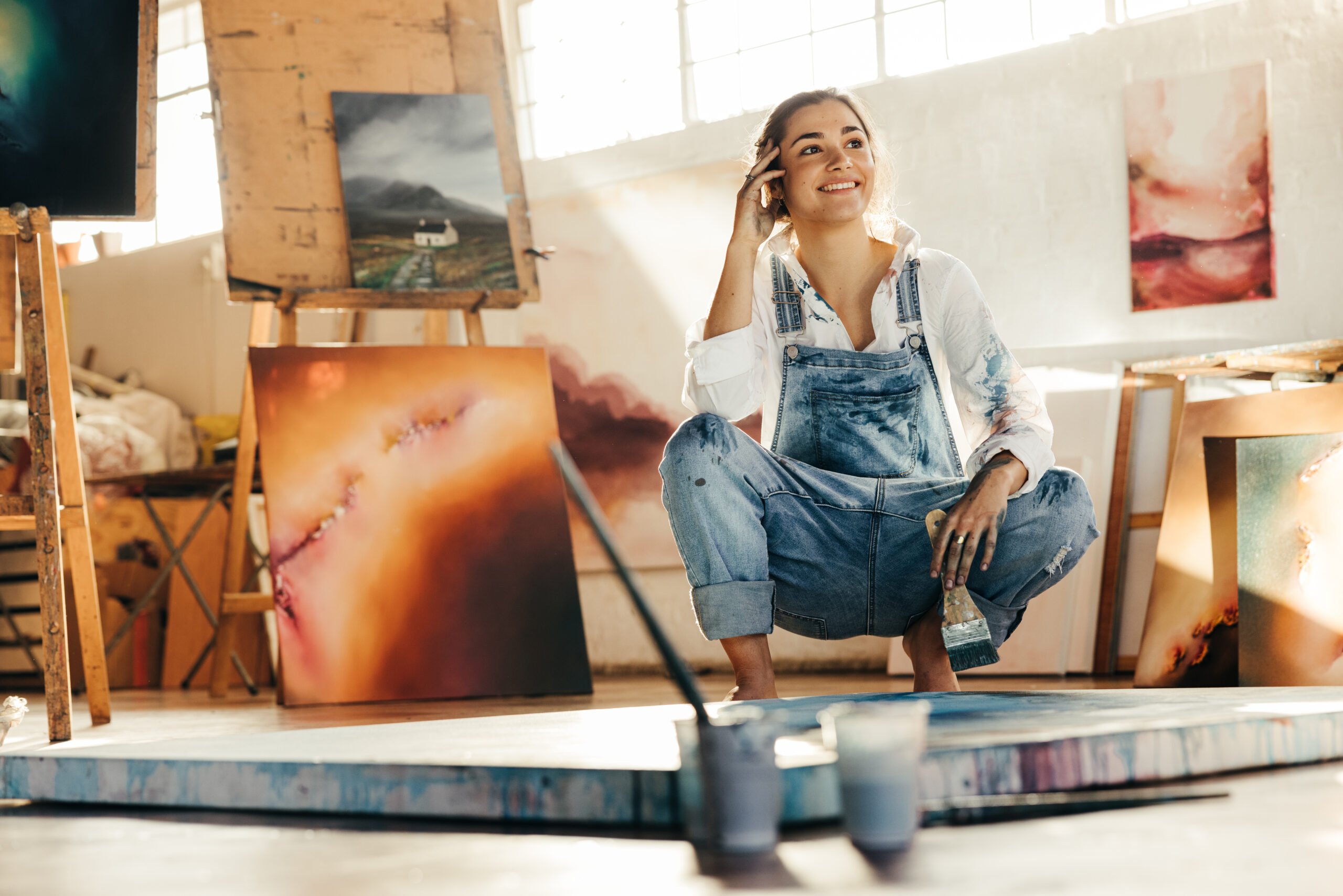As an artist in Austin, finding the right places to sell your art can be overwhelming. This guide cuts through the noise, offering straightforward options on where to sell art in Austin. From art galleries to online marketplaces, we outline practical venues and strategies to help you succeed in Austin’s thriving art market.
Asherfield: Discover, buy, and sell high-end pieces
Key Takeaways
Austin’s art scene is vibrant and diverse, offering a range of venues for artists to display and sell their work, including world-class museums, local galleries, outdoor markets, and digital platforms.
Competitive art galleries like Austin Galleries require artists to submit high-resolution images and details about their pieces for consideration, and successful consignment requires alignment with market demands.
Opportunities for artists to sell their work extend to auction houses, consignment shops, special events, studio visits, and by teaching workshops, broadening potential revenue streams and exposure.
Navigating Austin’s Art Scene: A Primer

The art scene in Austin is a diverse panorama that caters to artists across different genres. The city is a hub for creatives, including:
designers
painters
sculptors
writers
photographers
filmmakers
dancers
musicians
All of whom contribute to its vibrant artistic energy. Cultural heritage holds a significant place in Austin’s art scene, with institutions like the Mexic-Arte Museum and the Carver Museum dedicated to preserving and exhibiting cultural treasures.
Dance, choreography, and Texas history are celebrated by organizations such as Ballet Austin at the Long Center and the Bullock Museum, showcasing the vibrancy of Austin’s performance art. Austin’s thriving art scene provides a conducive environment for local artists to display and sell their work, with venues and institutions supporting artistic endeavors. The Blanton and the Harry Ransom Center are among the world-class museums offering platforms for artistic exposure.
Showcasing Your Work: Austin Art Galleries

Local artists can find fantastic platforms to exhibit their work in Austin’s art galleries. For example, Austin Galleries, a significant venue since 1964, offers consignment opportunities for artists and showcases pieces from prominent Texas collections. However, securing a spot in these galleries can be competitive, with Austin Galleries receiving over 150 new applications monthly.
The initial review process requires artists to send high-resolution images of their artwork to the gallery, along with the artist’s name and dimensions of the pieces.
Gallery Highlights
Among the numerous galleries in Austin, The Contemporary at the Jones Center stands out. This gallery is recognized for its support of both new and established artists, making it a key venue for local artists to present their work and gain exposure.
Submission Success
Careful preparation is key to successfully consign artwork with Austin Galleries. Artists must provide high-resolution images of their work along with their name and the artwork’s dimensions. The selection process involves a thorough review to ensure the artwork aligns with market demands. Once the artwork is accepted, the gallery conducts market suitability research and drafts a consignment agreement with an estimated value for the piece. However, the competitive nature of the Austin art scene means that Austin Galleries receives over 150 applications monthly to consign art.
The Power of Outdoor Markets

Unique opportunities for artists are prevalent in Austin’s outdoor markets. These markets operate in a lively atmosphere that attracts a diverse crowd, providing artists with a chance to showcase and sell their work. Some of the popular outdoor markets in Austin include:
The 23rd Street Artist Market, operating daily from 8:00 am until dusk
The HOPE Farmers Market, held every Sunday from 11:00 am to 3:00 pm
The Blue Genie Art Bazaar, a holiday market that runs from late November to Christmas Eve
These markets offer a great platform for artists to connect with potential buyers and gain exposure for their work.
Moreover, art and music often go hand in hand at Austin’s outdoor events. The Austin Blues Festival at Moody Amphitheater, for instance, is an annual event where artists can sell their work while attendees enjoy blues music. There are also opportunities to showcase and sell artworks during the Zilker Summer Musical, which features free outdoor theater performances.
Market Calendar
Throughout the year, the city hosts several markets where artists can sell their creations. The Dripping Springs Holiday Markets in Austin, for example, are an excellent opportunity for artists to sell their work during the festive season. For year-round selling, artists can rely on markets like the Gibson Street Artisan Market, open Friday to Sunday from 11 a.m. to 5 p.m., with extended hours in the holiday season.
Artists seeking a venue with unique appeal can consider the following markets in Austin:
23rd Street Artist Market, known for its distinctive handicrafts
Gibson Street Artisan Market, featuring a range of handmade items from paintings to jewelry and pottery
Markets supporting specialties like segmented wood pottery and decorative arts, synonymous with creators like Heiko Weiner
These markets add diversity to an artist’s market calendar and highlight the diverse local artist community in Austin.
Vendor Voices
Many artists have found outdoor markets to be profitable venues. The Art From the Streets Studio Tour & Sale, for instance, not only provides a platform for artists to display and sell their original works but also supports local homeless and formerly homeless artists by offering wall space for their art.
These success stories underscore the potential of outdoor markets as a viable channel for artists seeking to sell their work.
Digital Platforms & Local Art Sales

Online platforms in the digital age offer artists additional avenues to reach a wider audience and sell their art. The Austin Artists Market, a dedicated digital platform for showcasing Austin’s art, and Instagram shopping, allow artists to sell their work directly to consumers through the platform. To facilitate online art sales, artists should provide comprehensive descriptions, quality images, clear pricing, and details on how to purchase.
This trend of selling art online allows local Austin artists to reach both local and global art collectors.
Virtual Visibility
Understanding the basics of Search Engine Optimization (SEO) is crucial for artists seeking to enhance the online discoverability of their portfolio websites for online art sales. Some key strategies to consider include:
Using SEO-friendly title tags
Creating detailed webpage content
Including searchable HTML text
Creating multiple web pages focusing on different aspects of your work
By implementing these strategies, you can improve your search engine rankings and increase your online presence.
Additionally, engagement on social media can increase an artist’s online visibility and may lead to their work appearing in Google Search results. Developing a trusted brand and online presence through SEO efforts requires time and patience for effective results.
Social Selling
Artists should opt for a memorable social media handle reflecting their artistic identity and resonating with their niche for effective social selling. Hashtags should be used strategically in posts and profiles to improve discoverability and reach a wider audience on social media.
More creative approaches can also be considered. For instance, artists can leverage trending sounds on TikTok and use hashtags relevant to their niche to connect with followers and promote their work.
Engaging with the audience on social media platforms by responding to comments, messages, and mentions fosters a more interconnected community and can increase art sales.
Collaborate and Conquer: Art Co-Ops and Collectives

Artists can collaborate, network, and share responsibilities in organizing events and exhibitions through art co-ops and collectives. Group shows at art cooperatives and collectives offer shared responsibilities among artists, making it easier to organize events.
Additionally, participating in group shows within a cooperative or collective setting facilitates networking with other local artists.
Co-Op Spotlights
Several art co-ops that support local artists are based in Austin. The Artists Screen Printing Co-Op is one such organization that provides a space for screen printers to improve their craft. This co-op includes facilities and a community environment that supports local artists in their screen printing endeavors.
In addition, the Artists Screen Printing Co-Op also offers educational classes to artists of all levels of experience.
Membership Matters
Both benefits and expectations come along with joining an art cooperative in Austin. To join, applicants must prove their competence with their chosen medium and undergo a studio and safety orientation. Art cooperatives provide a range of membership options with varying durations and costs, including discounts for interns, recent college graduates, and university students.
New members of art cooperatives can benefit from incentives like a 50% discount on the first month’s dues or waived membership fees for the first year. Membership in an art cooperative comes with opportunities for artists to gain practical experience and develop professional skills, including participation in internships. However, members are typically expected to contribute to operational tasks as part of their working membership agreement, which may include cleaning and restocking.
From Canvas to Collection: Auction Houses in Austin
Auction houses in Austin offer artists an alternative platform to reach a diverse range of collectors and sell their work. Austin Auction Gallery, established in 1983, is known for its wide range of collectibles including fine art, antiques, jewelry, and more. These auction houses offer multiple services, orchestrating thousands of auctions for various valuable items. Events like the June Spectacular Multi-Estates Auction hosted by Austin Auction Gallery mark major highlights in the city’s auction calendar.
Auction houses in Austin have facilitated the sale of historic artifacts including a notable 1st-century piece, underscoring their role in the conservation and trade of antiquities. Moreover, venues like Austin Galleries provide artists with alternative opportunities to sell their creations outside of the more traditional art gallery circuit.
Auction Insights
Guiding both buyers and sellers through the auction process, Austin Auction Gallery operates with a comprehensive facility and a team of experts. Artists and estate executors can collaborate with Austin Auction Gallery to optimize the sales outcome of their auctioned items. Some notable sales at Austin Auction Gallery include:
Art glass
Fine jewelry
Antiques
Artwork from recognized artists
A Tiffany Studios NY Dore Bronze 18-Light Lily Lamp sold for $35,000 and art by Porfirio Salinas are among the high-ticket items auctioned at the gallery.
Auction houses in Austin also play a crucial role in certifying the authenticity and determining the period of pieces. For instance, a marble sculpture traced back to the first century was sold through an auction house, highlighting their role in the conservation and trade of antiquities.
Success Stories
Contributing to Austin’s reputation as a thriving art market, its auction houses have served as a significant platform for local artists to sell their work. One artist recounted how their first significant sale at an Austin auction house was a defining moment in their career, leading to more recognition and subsequent sales.
A diverse range of art has found success at Austin’s auctions, from contemporary paintings to mixed media installations. Several artists have expressed gratitude for the role auction houses have played in elevating their status within the artistic community and improving their financial stability.
Creative Consignment Shops
Offering a unique structure for artists to sell their work during special events, creative consignment shops like the Blue Genie Art Bazaar are available. The Blue Genie Art Bazaar is a standout venue that allows artists to sell their work without the need to man their booths throughout the event.
Artists looking to feature their work at Blue Genie Art Bazaar must:
Apply for participation ahead of the event
The event spans the entire month before Christmas
This represents a significant opportunity for artists to maximize their exposure and sales during the busy holiday season.
Furthermore, the Blue Genie Art Bazaar manages the sales process with their own staff, providing assistance to customers and handling transactions for the artists.
Diversify Your Art Sales: Festivals and Special Events
Festivals and special events in Austin provide artists with the opportunity to diversify sales channels, an effective strategy. Artists have various venues available for selling their work throughout the year, including festivals and studio tours. The Big Medium’s East or West Austin Studio Tours are notable events that offer art sales opportunities for local artists.
Additionally, the Viva la Vida Festival is an annual downtown event that offers the following:
Artists can sell their pieces
Live performances
Art activities
Live music and entertainment
These events contribute to a lively atmosphere that attracts art buyers and enthusiasts.
Event Breakdown
Several annual events in Austin, such as the Spring Pecan Street Festival and the Armadillo Christmas Bazaar, are known for attracting art buyers and collectors. The Spring Pecan Street Festival, a juried arts event, takes place biannually in downtown Austin’s Sixth Street Historic District, attracting artists and attendees with its commitment to the arts.
The Armadillo Christmas Bazaar is an iconic Austin festival that merges the sale of art and handmade gifts with live music, offering a festive shopping experience. For a more unique experience, the LEVITATION festival—once known as Austin Psych Fest—stands out by including visual arts, the Mad Alchemy Light Show, and a blend of psych rock and indie music, catering to a unique audience that appreciates both art and music.
Each festival and event provides distinct opportunities for artists to connect with a wider audience, showcasing their skills and selling artworks directly to an interested and engaged crowd. Furthermore, the Viva la Vida Festival includes opportunities for artists to sell their work at local artist and retail booths, part of a larger cultural celebration featuring a grand procession and live entertainment.
Festival Tips
Successful participation in art festivals requires thorough preparation. Artists applying to festivals should prepare with an effective booth design and understand the logistics of transport and setup, as well as any outdoor event requirements such as needing a tent. Craft fair booths typically come with a defined amount of space and artists need to bring their own equipment like tables or chairs, along with other essentials like snacks, water, tools, business cards, price tags, and packaging for sold items.
Moreover, artists should be ready to handle transactions, which includes having a sales tax permit, cash and coins for change, and a card reader for credit card payments. To fully capitalize on the festival experience, artists should engage with curious customers about their creative process and make connections with fellow vendors to discover additional opportunities.
Direct to Your Doorstep: Home Shows and Studio Visits
Artists can showcase and sell their work directly to buyers in a more personal and intimate setting through home shows and studio visits. Having a structured itinerary for an open studio tour can make guests feel welcome and can include elements like:
a reception with beverages or snacks
a guided tour of the studio
live demonstrations of the artist’s process
opportunities for guests to ask questions and interact with the artist
Providing guests with accurate directions and contact information ensures they can find the venue easily, and having a time limit keeps the event focused.
Being honest about nervousness as an artist can create a memorable impression. Here are some tips to make your guest visit interactive and enjoyable:
Prepare questions to engage guests and encourage conversation.
Consider having a co-host to help ensure guests feel welcomed and comfortable.
Take the time to explain your artwork carefully, enhancing their appreciation and creating a more personal buying experience.
Expanding Horizons: Workshops and Art Classes
Artists can share their skills, expand their exposure, and generate additional income by teaching workshops and art classes in Austin. Austin offers opportunities for artists to teach a variety of creative skills, such as modern calligraphy and line drawing, through workshops offered by local organizations.
Mud Studio in Austin gives artists the platform to provide ceramics workshops and classes, sharing their expertise in pottery and ceramics creation with students of different skill levels. The Butler Center for Dance & Fitness, for instance, offers artists opportunities to lead a wide range of dance classes, incorporating the art of movement. Artists can also offer workshops teaching the technique of water marbling on textiles and silk, catering to both in-person and online participants.
All these opportunities not only provide artists with additional streams of income but also enhance their public exposure in the community.
Summary
In conclusion, Austin’s vibrant art scene offers a myriad of opportunities for artists to showcase and sell their work. From world-class galleries and lively outdoor markets to digital platforms and art cooperatives, the city provides an ideal environment for artists to flourish. Whether you’re a painter, sculptor, or mixed media artist, there’s a platform in Austin that caters to your unique needs. So why not take the leap and explore the diverse avenues to sell your art in Austin?
Frequently Asked Questions
How can I sell my art in Austin’s galleries?
To sell your art in Austin’s galleries, you’ll need to go through an application review process, which involves submitting high-resolution images of your artwork along with your name and the dimensions of the pieces. Good luck!
What are some popular outdoor markets in Austin for selling art?
Some popular outdoor markets in Austin for selling art include the 23rd Street Artist Market, the Austin Blues Festival at Moody Amphitheater, and the Dripping Springs Holiday Markets.
How can I improve my online visibility to sell art?
To improve your online visibility and sell more art, focus on mastering SEO, optimizing social media profiles, and engaging with your audience. These strategies can greatly enhance your online presence and boost sales.
What are the benefits of joining an art cooperative in Austin?
Joining an art cooperative in Austin can provide artists with opportunities for collaboration, networking, shared event organization, and practical experience. These benefits can enhance an artist’s career and skill set.
Can I sell my art at festivals and special events in Austin?
Yes, Austin hosts annual art festivals and special events where artists can sell their work. It’s a great opportunity to showcase your art (Date: not applicable).
